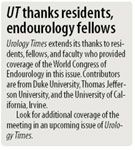Article
Ischemic time, excised tissue affect post-laparoscopic partial nephrectomy outcome
Researchers have identified the two most important factors that affect kidney function following surgery: increasing warm ischemia time and the amount of parenchyma excised.

One question about the procedure that has remained unanswered is, which factors affect kidney function following surgery. In a study presented at the World Congress of Endourology, surgeons at the Cleveland Clinic identified the two most important determinants: increasing warm ischemia time and the amount of parenchyma excised.
Like open partial nephrectomy, cold ischemia can be established during laparoscopic partial nephrectomy; however, it is cumbersome, technically difficult, and rarely used. Although some animal studies suggest that warm ischemia up to 90 minutes may not have deleterious effects on the kidney, recent clinical data from patients with solitary kidney undergoing partial nephrectomy suggest that even a short interval of warm ischemia (>20 minutes) can significantly increase the risk of acute renal failure and chronic renal insufficiency. The effect of renal ischemia can be easily assessed in patients with a solitary kidney; however, it can be difficult to assess in a patient with normal contralateral kidneys.

Mean patient age was 60.2 years (range, 33 to 82 years), and the mean tumor diameter was 3.1 cm (range, 0.7 to 10.3 cm). Within this patient population, 47 had central tumors, 37 had preoperative hypertension, 11 had diabetes mellitus, and 24 had renal insufficiency defined as eGFR <60 mL/min (grade 3 chronic kidney disease). Mean warm ischemia time (WIT) was 36 minutes (range, 15 to 60 minutes).
The patients were stratified into three groups based on WIT (<30 minutes, 30 to 40 minutes, and >40 minutes). As expected, larger tumor size was associated with longer WIT and operative times and higher blood loss.
On univariate analysis, al- though there was no difference in the percentage of kidney parenchyma excised, pa- tients with longer WIT had significantly decreased eGFR (p=.03) and split renal function on MAG-3 renal scan (p=.03), reported first author Monish Aron, MD, clinical fellow in laparoscopic and robotic urology. Postoperatively, the mean decrease in split renal function of the operated kidney was 8.8%, and the mean decrease in eGFR was 14.4 mL/minute. Overall, 35% patients had a >20% de- crease in split renal function and 50% of patients had a >20% decrease in eGFR.
On a multivariate logistic regression analysis, only percentage of kidney ex- cised and WIT predicted a >20% decrease in split renal function and eGFR (p=.02 and .01, respectively).
"These data indicate that warm ischemia time is the most important predictor of decrease in renal function after LPN," Dr. Aron said. "The negative correlation is almost linear, suggesting that every effort should be made to keep the ischemia time to a minimum. Amount of kidney parenchyma excised is likely an important determinant, although it is limited by its subjective nature."
Warm ischemia: How long?
Although the study provides information on the factors predicting decreased renal function after warm ischemia, the issue of renal tolerance to warm ischemia remains largely unsettled.
"The magic number of limiting warm ischemia to 30 minutes is largely based on older studies," said session co-moderator Louis R. Kavoussi, MD, chair of urology at the Smith Institute of Urology, North Shore-Long Island Jewish Health System, New Hyde Park, NY. "We do not know the real answer as to how long a kidney can tolerate warm ischemia without having any permanent loss in function. Every kidney probably responds differently to warm ischemia, depending on the patient's age and associated atherosclerosis.
"It was reassuring to see that no huge losses in renal function were seen in this study; however, until more data is available, we should keep the warm ischemia to minimum."
Co-moderator M. Pilar Laguna, MD, of UMC St. Radboud, Nijmegen, the Netherlands, emphasized the lack of markers for accurately measuring loss of renal function in a patient with a normal contralateral kidney undergoing laparoscopic partial nephrectomy.
"eGFR is not very accurate in measuring the loss of renal function in this situation, as it measures the function of both kidneys put together," Dr. Laguna said. "Further research looking at novel markers to assess long-term renal function in this setting is warranted."
Although no patients in this study had complete loss of a renal unit, in 21% of patients with preoperative GFR >60 mL/min (range, 61 to 87 mL/min), the postoperative eGFR declined to a mean of 53 mL/min within 6 months. It is unclear whether this loss of renal function is from excision of normal renal parenchyma surrounding the tumor or from warm ischemia.
With the increasing use of new technologies for the management of renal masses, one interesting avenue of research would be to examine how LPN (with hilar clamping) compares with renal ablation (radiofrequency and cryoablation) and LPN (without hilar clamping) in preserving renal function.




